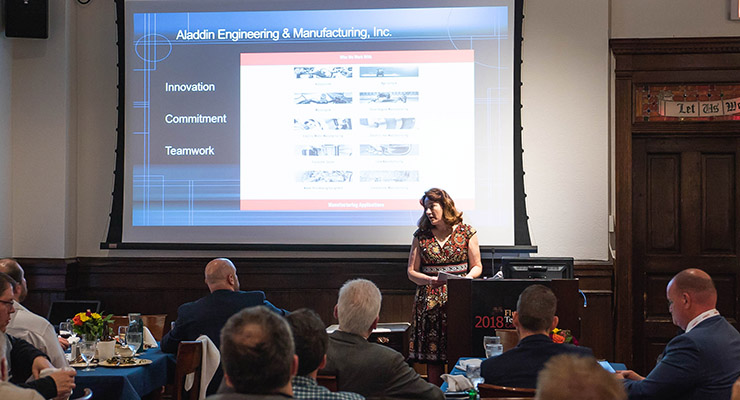 This year’s Fluid Power Technology Conference opened last night with a VIP dinner, and the evening’s keynote speaker gave an interesting and impassioned talk. Natalie Bell, the President of Aladdin Engineering & Manufacturing and Aladco, spoke about the companies’ history as well as some of the current challenges that manufacturers are facing today.
This year’s Fluid Power Technology Conference opened last night with a VIP dinner, and the evening’s keynote speaker gave an interesting and impassioned talk. Natalie Bell, the President of Aladdin Engineering & Manufacturing and Aladco, spoke about the companies’ history as well as some of the current challenges that manufacturers are facing today.
Bell stressed that many companies are tending to focus on people as commodities. But we are each more than our technical expertise, we’re the sum of many different aspects that can’t easily—or fairly—be summarized on a spreadsheet.
“It’s important to me to know the whole person, not just the knowledge and skills,” she said. “It is my belief that accounting practices have devalued employees as unique people, especially in manufacturing. The alarm is now sounding because the needed head count is not available.”
Bell said the devaluing of technical workers over the past 25 years has severely constricted the pipeline of younger workers going into the technical field—regardless of the gender.
“Today, we see computers running 3D software, versus drawing boards, scales and different diameter and color pencils,” she said. “The basics of mechanical engineering are still the same—engineering mechanics, hydraulic machines, thermodynamics, internal combustion engines, engineering materials, industrial engineering and production management, and hydraulics and fluid mechanics. The basics of electrical engineering is just as comprehensive. But after schooling is complete, a new graduate still needs experience to be marketable. How do they get this experience?”
Bell noted that the current starting salary for graduate engineers is too much for many small businesses to cover while they learn on the job. Many large businesses are not willing to invest in training, as they did from the 1950s through the 1960s, because it lowers profits. She said that it’s a Catch-22.
Bell displayed an original job advertisement that her grandfather had created six decades ago It listed:
• Preferred education is high school plus four years technical training or engineering degree.
• Duties including the ability to do original layout and design of complete projects, supervise others as a group leader, check complete projects, and do calculations as required.
• A composite rate of $8.25 per hour for 50 hours was allowed then. The wage calculates to $21,450 per year.
“Aladdin Engineering and Manufacturing is still looking for this type of design engineer today, and some of your companies may be also,” she said. “They are unicorns. The main reason, in my opinion, is the solid rate of growth. In the 1970s, when manufacturing began leaving the U.S., that discouraged young people from going into STEM careers. That trend has not changed until recently.”
Using the 1950 salary compared to a STEM salary of $65,000 today, Bell said that there has only been a 2% rate of growth over the past 60 years.
“I think one way to change this trend is for colleges like MSOE to recruit students—male and female—with high scores in any STEM discipline, like colleges recruit athletes, personal meetings with the student and their parents, more grants and scholarships,” she said. “Students and their parents need to see a viable future career, and not a future of losing your job like a commodity in a cost of sales formula. STEM employees are not commodities on the product costing spreadsheet.”
Filed Under: News, Slider